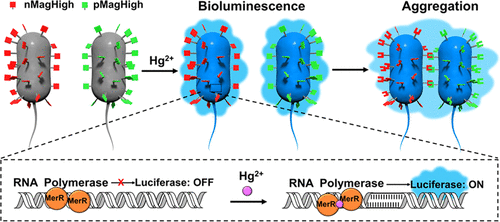Our official English website, www.x-mol.net, welcomes your feedback! (Note: you will need to create a separate account there.)
Bioluminescence-Triggered Photoswitchable Bacterial Adhesions Enable Higher Sensitivity and Dual-Readout Bacterial Biosensors for Mercury.
ACS Sensors ( IF 8.9 ) Pub Date : 2020-06-25 , DOI: 10.1021/acssensors.0c00855 Fei Chen 1 , Rachel L Warnock 2 , Jan Roelof Van der Meer 3 , Seraphine V Wegner 1
ACS Sensors ( IF 8.9 ) Pub Date : 2020-06-25 , DOI: 10.1021/acssensors.0c00855 Fei Chen 1 , Rachel L Warnock 2 , Jan Roelof Van der Meer 3 , Seraphine V Wegner 1
Affiliation

|
We present a new concept for whole-cell biosensors that couples the response to Hg2+ with bioluminescence and bacterial aggregation. This allows us to use the bacterial aggregation to preconcentrate the bioluminescent bacteria at the substrate surface and increase the sensitivity of Hg2+ detection. This whole-cell biosensor combines a Hg2+-sensitive bioluminescence reporter and light-responsive bacterial cell–cell adhesions. We demonstrate that the blue luminescence in response to Hg2+ is able to photoactivate bacterial aggregation, which provides a second readout for Hg2+ detection. In return, the Hg2+-triggered bacterial aggregation leads to faster sedimentation and more efficient formation of biofilms. At low Hg2+ concentrations, the enrichment of the bacteria in biofilms leads to an up to 10-fold increase in the signal. The activation of photoswitchable proteins with biological light is a new concept in optogenetics, and the presented bacterial biosensor design is transferable to other bioluminescent reporters with particular interest for environmental monitoring.
中文翻译:

生物发光触发的光开关细菌附着力可实现更高的汞敏感性和双读数细菌生物传感器。
我们提出了一种全细胞生物传感器的新概念,它将对Hg 2+的响应与生物发光和细菌聚集相结合。这使我们能够利用细菌聚集体将生物发光细菌预先浓缩在底物表面,并提高Hg 2+检测的灵敏度。这种全细胞生物传感器结合了对Hg 2+敏感的生物发光报告分子和对光敏感的细菌细胞间粘附。我们证明响应Hg 2+的蓝色发光能够光激活细菌聚集,这为Hg 2+检测提供了第二个读数。作为回报,汞2+触发的细菌聚集导致更快的沉降和更有效的生物膜形成。在低Hg 2+浓度下,细菌在生物膜中的富集导致信号增加多达10倍。用生物光激活光可开关蛋白是光遗传学中的一个新概念,并且提出的细菌生物传感器设计可转移到其他生物发光报告基因中,对环境监测特别感兴趣。
更新日期:2020-07-24
中文翻译:

生物发光触发的光开关细菌附着力可实现更高的汞敏感性和双读数细菌生物传感器。
我们提出了一种全细胞生物传感器的新概念,它将对Hg 2+的响应与生物发光和细菌聚集相结合。这使我们能够利用细菌聚集体将生物发光细菌预先浓缩在底物表面,并提高Hg 2+检测的灵敏度。这种全细胞生物传感器结合了对Hg 2+敏感的生物发光报告分子和对光敏感的细菌细胞间粘附。我们证明响应Hg 2+的蓝色发光能够光激活细菌聚集,这为Hg 2+检测提供了第二个读数。作为回报,汞2+触发的细菌聚集导致更快的沉降和更有效的生物膜形成。在低Hg 2+浓度下,细菌在生物膜中的富集导致信号增加多达10倍。用生物光激活光可开关蛋白是光遗传学中的一个新概念,并且提出的细菌生物传感器设计可转移到其他生物发光报告基因中,对环境监测特别感兴趣。


























 京公网安备 11010802027423号
京公网安备 11010802027423号